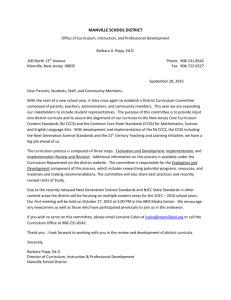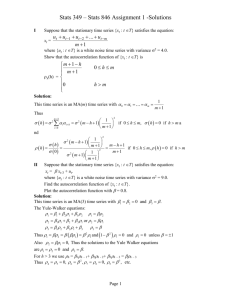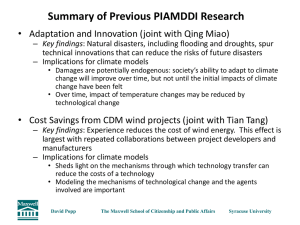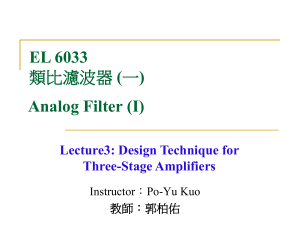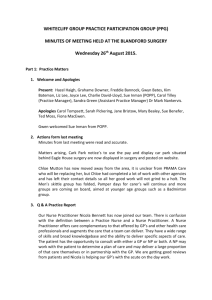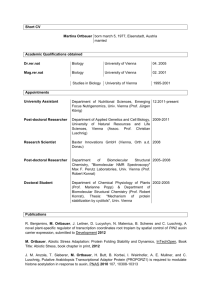Climate Policy and Induced R&D: How Great is the Effect? 1
advertisement
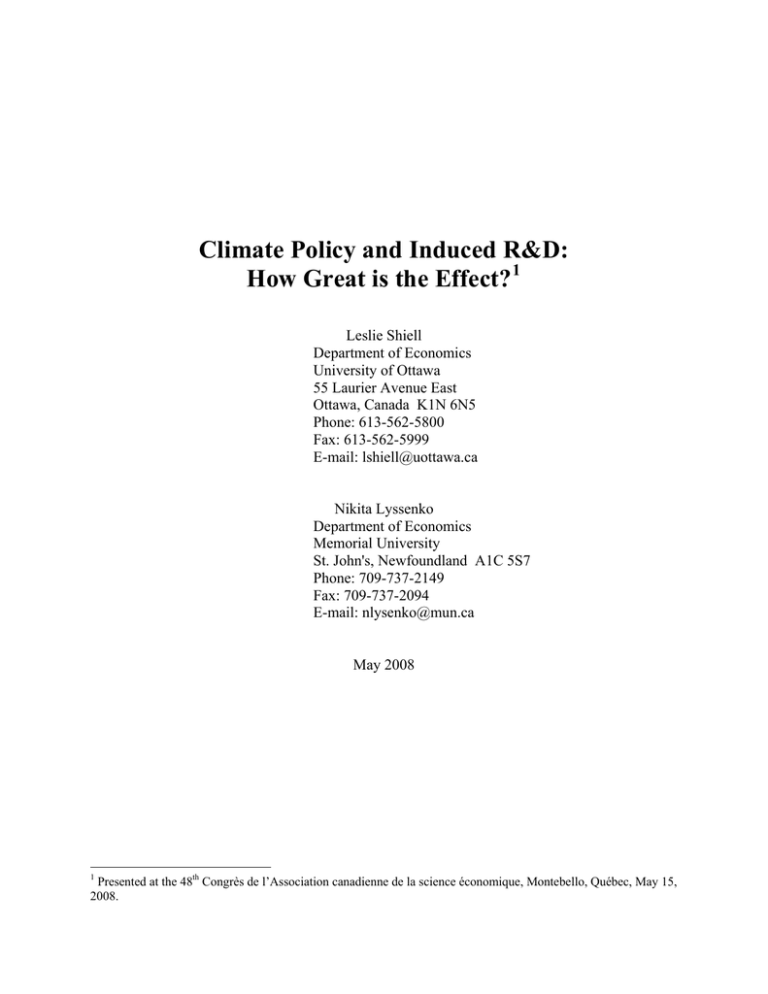
Climate Policy and Induced R&D: How Great is the Effect?1 Leslie Shiell Department of Economics University of Ottawa 55 Laurier Avenue East Ottawa, Canada K1N 6N5 Phone: 613-562-5800 Fax: 613-562-5999 E-mail: lshiell@uottawa.ca Nikita Lyssenko Department of Economics Memorial University St. John's, Newfoundland A1C 5S7 Phone: 709-737-2149 Fax: 709-737-2094 E-mail: nlysenko@mun.ca May 2008 1 Presented at the 48th Congrès de l’Association canadienne de la science économique, Montebello, Québec, May 15, 2008. I. Introduction Carbon taxes or tradable permit systems are likely to induce increased technical research and development, which in turn will help reduce the cost of emissions abatement. However, recent research (e.g. Goulder and Schneider 1999) cautions that the social benefit of induced R&D may in fact be quite limited. Apart from the fact that R&D is costly, the social benefits are further limited by imperfections in the market for research. Private firms are only able to appropriate a small portion of the total benefits, and thus they spend too little on R&D. In addition, much of the induced research represents a displacement of effort from other sectors rather than a net increase. Another factor which influences the payoff to R&D is the contribution of existing human capital in the research process itself. Does a higher level of existing human capital mean that current R&D spending will be more productive or less? This linkage is referred to as an intertemporal knowledge spillover, and it is distinct from the inter-firm knowledge spillover described above. Popp (2004) seeks to empirically calibrate the size of these effects, in obtaining an overall estimate of the benefit of induced R&D associated with climate change policy. Using the ENTICE model, he estimates that adding an R&D component increases the welfare impact of the optimal climate policy by only 8 percent in the central scenario – a modest change. Unfortunately, we find that Popp’s results are primarily an artifact of his modeling assumptions and calibration. In particular, he models inter-firm spillovers and research crowding-out as second-best constraints on the planner’s optimization problem, rather than as externalities. Further, he neglects to impose the spillover constraint in the first period of the model, with the result that spillovers are in fact wholly internalized in the first period. We present preliminary results from our efforts to improve the model. We impose the spillover constraint in the first period, and make other changes in the modeling and calibration. We hope to be able to model spillovers and crowding-out as externalities in a future draft of the paper; however, we have not been successful to date in this objective, and therefore we follow Popp’s second-best approach below. Our preliminary results indicate that these modeling choices are crucial. Imposing the spillover constraint in the first period turns Popp’s reported welfare gain into a loss – i.e. society is worse off with induced innovation under the optimal climate policy than it would be without 1 it. Furthermore, the gain in welfare between optimally controlling greenhouse gas emissions and doing nothing is insignificant. Notwithstanding these results, we do not believe that the welfare gain from optimal climate policy is insignificant. Rather, we hypothesize that the second-best approach in the model leads to an over-accumulation of capital in the no-policy scenario. It follows that the incremental gain of climate policy is small. Further, in the context of small gains from climate policy, it appears that the distortionary effect of the second-best spillover constraint is more costly than any benefit which can be obtained from marginal increases in research. In the real world, of course, knowledge spillovers and crowding out of other research are treated by firms as externalities, not as second-best constraints. Therefore, it is essential to structure the model accordingly. In its present form, we do not believe that ENTICE provides credible answers to questions about induced innovation and climate policy. The next section describes the ENTICE model structure. Section III describes Popp’s sources and methods for initial values and calibration. Section IV presents in detail our critique of his model structure and calibration. Section V presents our approach to modeling and calibration. Section VI presents our results, and Section VII concludes. II. ENTICE model structure Popp’s ENTICE model is based on Nordhaus’ DICE 99 model (Dynamic Integrated model of the Climate and Economy) (Nordhaus and Boyer 2000). It is a single-region growth model with an environmental module to account for negative impacts of greenhouse gas emissions. Time proceeds in discrete steps of 10 years each, with periods denoted t = 1,..., T . The initial period corresponds with the decade 1990-2000. The terminal period is 35 (T = 35), for a total planning horizon of 350 years. In any given period, gross output, Qt, is given by the Cobb-Douglas production function Q t = A t K γt L1t− γ −β EN βt (1) where Kt denotes physical capital, Lt denotes labour, ENt denotes energy services, and At denotes total factor productivity. Labour and total factor productivity are assumed to follow exogenous trends, growing exponentially but at declining rates. Details of these trends are discussed in Nordhaus and Boyer (2000). 2 Physical capital evolves according to the difference equation K t +1 = (1 − δ K ) Δ K t + Δ[I t − R t ⋅ oppcost ⋅ crowd ] (2) where It represents investment, Rt represents energy-related research spending, δK represents the annual depreciation rate, Δ represents the period duration (10 years), oppcost represents additional opportunity cost associated with research spending (discussed below), and crowd represents the proportion of energy-related research spending which is obtained by crowding out research spending in other sectors. Energy services are provided by an effective fuel input, F̂t , and energy-related human capital, Ht, according to the CES function [ EN t = α H H ρt + α F F̂tρ ] 1 ρ . (3) The effective fuel input is derived from gross fuel, Ft, according to the relationship F̂t = Ft , Φt (4) where 1 Φ t represents exogenously increasing technical change. Energy-related human capital evolves according to the difference equation [ ] h t ≡ H t +1 − H t = Δ aR bt H φt , (5) where the right-hand side is referred to as the research possibility frontier, or simply the research function. The value of the parameter b characterizes the “duplication externality” in research. Since research effort is spread out across many firms, it is likely that doubling the total amount of research spending will less than double the amount of new knowledge, as some firms duplicate results. Therefore, we expect 0 < b < 1 . The value of the parameter ϕ characterizes the intertemporal knowledge spillover. When φ > 0 , researchers “stand on the shoulders of giants,” as new discoveries become easier with more knowledge. When φ < 0 , research is a process of “fishing out the pond,” as new discoveries become more difficult the more is already known. When φ = 0 , the productivity of research is not affected by the amount of existing knowledge. Formally, this characteristic relates to the second derivative of the research function, as ϕ is positive, negative or zero. 3 ∂ 2h t , which is positive, negative, or zero ∂R t ∂H t The value of ϕ also determines returns to the amount of existing knowledge in research. This characteristic relates to the second derivative ∂ 2h t ∂H 2t . Assuming φ > 0 , so that the first ∂h t is positive (standing on the shoulders), the second derivative is positive if φ > 1 , ∂H t derivative zero if φ = 1 , and negative if 0 < φ < 1 . These cases refer respectively to increasing, constant and decreasing returns to Ht in the research process. Net output, Yt, is given by the function Yt = D(TE t )Q t − Pt Ft (6) where TEt denotes global mean temperature, Ft denotes the carbon-based fuel (also equal to emissions), and Pt denotes the price of fuel. The damage function, D(TE t ) , encapsulates the feedback of emissions (Ft) on global mean temperature (TEt). In a nutshell, emissions of greenhouse gases accumulate in the atmosphere, causing higher temperatures and reduced economic productivity. For brevity, we have omitted the equations which characterize this feedback. Interested readers may consult Popp (2004) or Nordhaus and Boyer (2000) for details. The price of carbon fuel, Pt, is an increasing function of the cumulative amount of fuel consumed to date; i.e. ( Pt = P ∑s =1 Fs t ) (7) where P ′(⋅) > 0 . This relationship reflects global scarcity of the carbon resource. It entails that Pt is increasing over time, as cumulative consumption increases. Details of the process are explained in Popp (2004) and Nordhaus and Boyer (2000). Consumption is denoted Ct. The production side of the model is closed by the material balance constraint Yt = C t + I t + R t . (8) Because individual firms are not able to appropriate the entire return from investments in R&D, they underinvest. As a consequence, the social marginal product of R&D spending is greater than the marginal product of physical capital investment. To capture this effect, Popp imposes a rate-of-return constraint, linking physical investment, I, with research expenditure, R. The rate of return on R is calculated as follows: 4 ∂Yt ∂Yt ∂EN t ∂h t = ∂R t ∂EN t ∂H t R t [ = βD(TE t )A t K γt L1t− γ −β α H H ρt + ] β −ρ α F F̂tρ ρ (9) α H abR bt −1H φt +ρ −1 The rate of return on I (net of depreciation) is calculated in the usual manner: [ ∂Yt ∂Yt = − δ K = γD(TE t )A t K γt −1L1t− γ −β α H H ρt + α F F̂tρ ∂I t ∂K t ] β ρ − δK (10) The rate-of-return constraint takes the form ∂Yt ∂Y =κ t , ∂R t ∂I t (11) where κ > 1 represents the factor by which the social return to R exceeds the return to I. Preferences are expressed in terms of a representative agent. The agent derives instantaneous utility, U, from per capita consumption, according to the logarithmic function U(C t L t ) = ln(C t L t ) . (12) Global welfare is measured by a utilitarian function T W = ∑ θ t L t U (C t L t ) (13) t =1 where θ t represents a utility discount factor. θ t is based on an initial rate of time preference equal to 3 percent per annum which declines in subsequent periods. Details of discounting are provided in Nordhaus and Boyer (2000). The representative agent chooses the time paths of flow variables C, I, R, and F to maximize global welfare (13), subject to the constraints (1) – (12), and given initial values K0, H0, and TE0. In the business-as-usual scenario (BAU), no policy is implemented to control greenhouse gas emissions. In another scenario, emissions control policy is chosen optimally, as part of the welfare maximization process. This scenario corresponds with an optimal, time varying carbon tax, or alternatively with a tradable permits scheme where the level of permits is chosen optimally in each period. 5 III. Values and calibration 1. Initial values and parameters Initial values of variables Y1, K1, L1, F1, R1, TE1, and P1 correspond with world values in 1990. Data do not exist for H1. Even if data did exist, the value could be normalized arbitrarily, which would affect the values of the scale parameters α H and a. Thus we can pick the value of H1 arbitrarily and let the calibration take care of the scale parameters. Popp uses a value of 0.0001, whereas we use a value of 0.01, which makes computational scaling easier in our simulations. 2 Capital’s share in gross output, γ, is assumed equal to 0.3, and the annual depreciation rate on capital, δK, is assumed to be 10 percent. Both assumptions are taken from Nordhaus and Boyer (2000). Energy’s share in gross output, β, is calculated as the proportion of initial output spent on fossil fuels, a value equal to 0.07029 (Popp 2004). Popp sets κ = oppcost = 4 , based on a review of relevant literature. The equality of κ and oppcost is most easily understood in the extreme case of complete crowding out ( crowd = 1 ), where an extra dollar of energy-related R&D comes at the expense of one less dollar for other types of R&D. Since the social marginal product of R&D is κ times greater than the marginal product of physical capital, it follows that crowding out one dollar of R&D in another sector is equivalent to crowding out κ dollars of physical capital. But since other R&D sectors are not represented explicitly in the model structure, it is necessary to gross up the measurement of opportunity cost in equation (2) by the product oppcost ⋅ crowd . In fact, evidence does not support the hypothesis of complete crowding out. Rather, Popp sets crowd = 0.5 in the central case, based on research using expenditure data. 2. Calibration Exogenous energy-related technical change, 1 Φ t , is calibrated to reproduce the values in DICE 99. Unlike ENTICE, DICE 99 does not contain an explicit fuel (emissions) variable; rather, output is a function of capital and labour, and emissions are modeled as a byproduct of production. The calibration of 1 Φ t ensures that both models produce the same emissions path in the business-as-usual scenario, in the absence of R&D. By assumption Φ1 = 1 . 2 All simulations are run using the GAMS software. 6 When induced innovation is added to the model, the trend of exogenous technical change must be scaled back by an appropriate amount, since it now represents only non-R&D related changes, such as might result from learning-by-doing, for example. In his central case, Popp reduces the trend of 1 Φ t by 20 percent (parameter exgscale equal to 0.20). In other words, 80 percent of exogenous technical change from DICE 99 remains in ENTICE in this case. There remain seven parameters to calibrate: the initial value of total factor productivity, A0; energy parameters α F , α H and ρ; and research parameters a, b and ϕ. Popp simplifies his task by assuming α F = 1 . (Indeed, his statement of equation 3 does not include this parameter.) The remaining six parameters are then calibrated based on the following four empirical observations: • The elasticity of energy R&D with respect to energy prices must equal 0.35, based on empirical research in Popp (2002). • Diminishing returns to energy R&D means that the elasticity must fall over time from the initial value of 0.35. • There exists an estimated 4:1 ratio of energy savings to energy R&D, based on empirical research in Popp (2001). • The initial value of total factor productivity, A1, must verify equations (1) and (3), given initial values of Y1, K1, L1, F1, H1, TE1, and P1. Details of his calibration strategy are provided in the appendices of Popp (2003, 2006) (but not Popp 2004). IV. Criticisms of the model and calibration 1. The calibration First, we note that the oppcost parameter should be equal to 3 rather than 4. As Popp explains, the fact that the social marginal product of Rt is 4 times the value of It means that crowding out one unit of R&D from another (non-energy) sector is equivalent to crowding out one unit of physical capital. Yet one unit of opportunity cost has already been accounted for in the material balance equation (8), leaving only three additional units to be accounted for by oppcost in equation (2). 7 Second, we observe that Popp does not take advantage of the initial value R 1 = 0.01 to calibrate any of the research parameters in the model. Rather, he simply imposes it as a fixed value in his computer code. 3 In light of the dearth of empirical information for calibrating parameters, we find this approach inefficient. Third, Popp’s claim of diminishing returns to energy R&D is not well founded. Rather, it appears to be based on confusion in an earlier paper, Popp (2002), between depreciation of knowledge capital and diminishing returns. As discussed in Section II, a positive value of ϕ in the research equation (5) corresponds with the “standing on the shoulders” hypothesis, under which the marginal product of research ∂h t ∂R t increases as the knowledge stock Ht increases. At the same time, the payoff to research is reduced if the knowledge stock depreciates over time due to obsolescence. It is this latter effect which the author mistakenly refers to as diminishing returns in Popp (2002). In contrast, there is no depreciation of the knowledge stock in ENTICE. Therefore, both the initial value of the research elasticity (0.35), taken from Popp (2002), and the requirement that it must fall over time may be inappropriate in ENTICE. Fourth, we find Popp’s calibration of the estimated 4:1 ratio of energy savings to energy R&D inappropriate. At best, this approach should be redundant, since the 4:1 relationship is already guaranteed by the rate-of-return constraint (equation 11). Worse, however, Popp’s handling of this condition appears to be conceptually flawed. The 4:1 ratio of marginal products between research and physical capital is an equilibrium result at the margin; i.e. it should hold for only the last units of R and I in every period. In contrast, infra-marginal units would not in general be expected to conform to this ratio. Nonetheless, Popp imposes this ratio as an average condition, which is not appropriate. 2. The model a. Second-best knowledge spillovers and crowding out, rather than externalities. Inter-firm knowledge spillovers and additional opportunity costs from crowding out nonenergy research (oppcost) are properly understood as externalities. Firms will choose their research levels without taking into account the benefits of knowledge spillovers since they cannot charge outsiders for these benefits. Similarly, firms perceive the opportunity cost of an 3 We are grateful to Popp for making his code available to us. 8 extra dollar of energy research as one less dollar spent elsewhere, even if that dollar could have leveraged 3 additional dollars in social benefits through knowledge spillovers. However, with the inclusion of oppcost in equation (2) and with the rate-of-return condition (11), Popp has modeled these effects as constraints on optimization rather than as externalities. As a consequence, the solution of the model must be understood as a second-best optimum, rather than a market equilibrium with externalities. Viewed another way, this modeling structure means that the representative agent take these effects into account, when, by definition of an externality, he should not. The second-best approach locks physical and knowledge capital together into a composite capital good, through the rate-of-return constraint (11). We envision two opposite effects of this approach. On the one hand, the agent would choose more It in every period than under an externality framework, since increasing It in the second best also makes it possible to increase Rt, which has a higher rate of return. In contrast, under an externality framework, the agent would not perceive the higher rate of return of Rt. On the other hand, the agent perceives the high opportunity cost of Rt in the second best, through oppcost, and therefore he chooses less Rt than in an externality framework. In the case of total crowing out (crowd = 1), we would expect these two effects to cancel out. However, since there is only partial crowding out in ENTICE (crowd = 0.5), the first effect should dominate – i.e. the second-best framework should lead to an over-accumulation of physical capital, compared with an externality framework. b. Inter-firm knowledge spillovers fully internalized in the first period. For reasons which are not clear, Popp does not impose the rate-of-return constraint (11) in the first period of the model, and neither does he impose the initial value R 1 = 0.01 under the optimal policy scenario. 4 It follows that the policy environment in the first period is first-best: in effect firms can appropriate all the benefits from research in the first period, and they are free to increase R1 to the point where its marginal product equals that of I1. Moreover, there is an incentive to over-invest in R1 in anticipation of the re-imposition of the rate-of-return constraint in period 2. As a result, we would expect to see a much higher value of R1 than we would observe in either the second-best or externality frameworks. 4 These results are only apparent in the computer code, not in his text. 9 c. Ad hoc BAU We have discussed Popp’s ad hoc approach to modeling the business-as-usual scenario (BAU) at length in Shiell and Lyssenko (2008). His approach consists of three steps. First, he solves the model without pollution damages. Second, he calculates the trajectory of the savings rate for this solution. Third, he uses this savings rate to calculate adjusted trajectories of Yt, Ct and Kt, iterating forward from the first period in the presence of pollution damages. This posthoc adjustment for damages works remarkably well for these three variables. Unfortunately, there appears to be no coherent way to extend the adjustment to the remaining variables. Thus, the values of ENt, Ft, Rt, Ht, TEt and any other variables of interest are based on the assumption of no damages, which is obviously not realistic. V. Revised calibration and modeling Notwithstanding our reservations about the appropriateness of the 0.35 elasticity value and the second-best approach, we continue with these practices here, due to the absence of practical alternatives. We identify the issue of the elasticity value for further research. Similarly, we have experimented with alternative computational methods which would treat research spillovers and crowding out as externalities, but none so far have proven satisfactory. While straightforward in theory, in practice this approach is quite challenging, as it involve adding two more externalities to the model. We employ the N-agent approach (Shiell and Lyssenko 2008) to modeling business-asusual. This approach models the no-policy equilibrium in a theoretically consistent way, in contrast with Popp’s ad hoc approach. Some simple changes include (i) we set the value of oppcost to 3, (ii) we dispense with the calibration of the 4:1 ratio of energy savings to energy R&D, and (iii) we impose the rate-ofreturn constraint (11) in the first period. We accept Popp’s initial values of variables, as well as his choices for γ, δK, β, κ and crowd. Except for the research elasticity, we employ a different approach from Popp to the calibration of A1, α F , α H , ρ, a, b and ϕ. To calibrate these parameters, we begin by obtaining an empirical measure of initial energy services, EN1. To do this, we define an efficiency factor, EFF, for the world energy 10 system, which measures the proportion of energy input converted into useful energy output. We then calculate EN1 = EFF ⋅ F1 . (14) F1 is provided in Popp (2004) and we obtain an estimate of EFF = 0.5 from Ziagos and Berry (2006) for the year 2005 (see their 2005 World Energy chart). 5 With this information, we solve (1) and (6) for A1, given Y1, K1, L1, EN1, TE1, F1, and P1. To calibrate α F , we begin by substituting (3) into (1) into (6), yielding 6 [ Y = AK γ L1− γ −β α H H ρ + α F F ρ ] β ρ −P⋅F. Taking the derivative with respect to F yields ∂Y β[Y + P ⋅ F] = α F F ρ−1 − P . ρ ∂F EN The first-order condition of the optimization problem involves setting this expression to zero (Lagrangian not shown), yielding the competitive outcome that marginal product equals price: 7 β[Y + P ⋅ F] α F Fρ−1 = P . ρ EN Solving for α F in the initial period, and taking advantage of (14), gives us a solution conditional on ρ, β and first-period values: αF = P1F1EFF ρ . β(Y1 + P1F1 ) (15) We then rearrange (3) to obtain a calibration of α H , conditional upon α F , ρ and firstperiod values: αH = EN1ρ − α F F1ρ H1ρ . (16) (Note that F̂1 = F1 , since Φ1 = 1 .) To calibrate a, we combine equations (9) – (11), with appropriate substitutions from (6) and (1), to yield in the first period 5 We note the discrepancy in the year of measurement between F1 (1990) and EFF (2005). We hope to rectify this discrepancy shortly. 6 Time subscripts have been dropped for convenience. 7 In fact, there should also be some shadow values on the right-hand side of this expression, to account for the pollution damages of emissions and scarcity rents. However, in BAU, these shadow values equal zero. 11 β Y1 + P1F1 EN1ρ α H abR 1b−1H1φ +ρ −1 = κγ Y1 + P1F1 − δK . K1 (17) This expression can be solved for a, conditional upon β, α H , b, ϕ, ρ and the initial values of the variables. Note that this calibration of a requires fixing the initial value R 1 = 0.01 . In contrast, in the solution of the model, the roles are reversed: a is fixed and R1 is variable. But given the calibration of a, there is only one value of R1 which solves the rate-of-return constraint in the first period, namely R 1 = 0.01 . Thus, unlike Popp, we do not need to impose R 1 = 0.01 in the model solution. To calibrate ρ, we proceed as follows. First, we choose arbitrary values of b, ϕ and ρ and then solve for α F , α H and a following (15) – (17). We then iterate on ρ to achieve the desired research elasticity of 0.35. For the purpose of calculating the elasticity, Popp defines research as the ratio R t Yt , in order to neutralize scale effects on the level of Rt. For simplicity, let rt represent this normalized value; i.e. rt ≡ Rt . Yt (18) The energy price used to calculate the elasticity includes the production cost Pt as well as shadow prices which influence the agent’s choices. In particular, we note that the agent’s first order condition with respect to F (Lagrangian not shown) yields the condition ∂Q t λM λCm = Pt + Yt + tY , ∂Ft λt λt where λMt represents the shadow value of atmospheric carbon, λCm represents the scarcity rent t on carbon fuels, and λYt represents the marginal utility of income. Thus the full price of carbon fuels includes terms relating to pollution damage and scarcity, as well as the production cost. Under business-as-usual, the pollution damage term ( λMt ) equals zero, since it represents an externality. Under the optimal policy scenario, however, this term would be positive, representing either the value of a tax on carbon emissions or the price of tradable emissions permits. As for the scarcity rent, λCm t , ENTICE is structured so that this value is fully 12 internalized in both BAU and optimal policy. We follow this approach as well. For simplicity, let π t represent the full price of carbon fuel; i.e. π t = Pt + λMt λYt + λCm t λYt . (19) Popp defines both inter and intra-temporal research elasticities respectively as rt +1 − rt 1 (r + rt ) 2 t +1 π t +1 − π t 1 ( π t +1 + π t ) 2 (20) and π *t − π̂ t rt* − r̂t 1 2 (rt* + r̂t ) 1 2 ( π *t + π̂ t ) , (21) where the asterisk and hat notation indicate alternative policy scenarios, e.g. optimal policy versus BAU. (20) defines the elasticity between periods for the same policy scenario, whereas (21) defines the elasticity across policy scenarios for the same period. The mechanism of induced innovation follows from the substitutability of H for F. If the price of F increases ceteris paribus, we would expect the agent to respond by undertaking more research, thus increasing H in subsequent periods. However, the price of fuel, π, is not the only determinant of R; in a given period, it will also depend on the existing level of H, through the research function (5), and on the level of Y, through the material balance condition (8). Since these values change between periods and between policy scenarios, there is an important conflict between the ceteris paribus requirement and the elasticity definitions (20) and (21). We acknowledge Popp’s effort to control for variations in Y through the normalization (18). However, we are not persuaded that this is adequate to meet the test of ceteris paribus. For one thing, the relationship between Y and R may not be linear. Second, there is no evidence that this approach adequately controls for variation in H. Finally, it is important to note that the optimal choice of R in any period will depend on the levels of variables in all periods, through the shadow value of human capital (not shown). For these reasons, we reject Popp’s use of the intertemporal elasticity (20) and his calibration strategy based on a diminishing value of this elasticity over time. Further, we note the importance of only applying the intra-temporal definition (21) in circumstances where all other values will be held constant. For our calibration, we apply (21) to measure the research elasticity 13 between the optimal policy and no-policy scenario (BAU) in the second period – the only period which almost fully meets the ceteris paribus requirement. We do not apply (21) in t = 1 since it is undefined in that period. To see this, note that the rate-of-return constraint (11) entails that R takes the same value in the first period in both BAU and the optimal policy scenario. This result is reasonable for our purposes, since it does not seem sensible to talk about the implementation of optimal policy in the decade 1990-2000 from the vantage point of 2008. Rather, we view t = 1 as an historical period. When the optimal policy is implemented, it is assumed to go into effect in t = 2 (2000-2010). It is important, therefore, to ensure that the values for t = 1 are truly historical; i.e. the agent does not have the option of responding in t = 1 to a policy change which will be implemented in t = 2 . To ensure this, we fix the first-period consumption level C1 at its BAU value in the optimal policy run of the model. 8 With this adjustment, we ensure that all variables are fixed across scenarios in t = 1 . It follows that the values of state variables in t = 2 are also constant across scenarios (i.e. K2, H2, TE2, P2). The values of flow variables are not constant across scenarios in t = 2 , as the agent chooses less fuel (F2) and more research (R2) in the optimal scenario than in BAU. However, the variation in net output (Y2) between scenarios turns out to be miniscule in this period, which is not surprising at the beginning of a new policy regime. Therefore, for all practical purposes, we have met the ceteris paribus requirement for the implementation of the elasticity formula (21). We do not regard the values obtained in subsequent periods as meaningful, due to the failure of ceteris paribus. After calibrating ρ to produce the desired elasticity value, we turn our attention to parameters b, ϕ, and exgscale. In the absence of useful empirical information, we rely on conjecture and sensitivity analysis. We expect some duplication externality, and therefore b < 1 . However, we do not expect too much, and therefore we assume a value of b = 0.75 . For ϕ, we perform sensitivity analysis at values φ = (0.75, 0.50, 0.25, 0.10, 0.00, − 0.10, − 0.25, − 0.50) . For exgscale, we perform sensitivity analysis at values exgscale = (0.2, 0.50) , i.e. a 20 percent 8 The initial state variables K1, H1, TE1 and P1 are fixed explicitly. Among flow variables, F1 is fixed explicitly, while R1 is fixed implicitly by the calibration of a, and Y1 is fixed implicitly by the calibration of A1. The remaining two flow variables, C1 and I1 are linked by the material balance equation (8). Fixing C1 therefore also fixes I1. 14 reduction in exogenous technical change, compared with DICE 99, and a 50 percent reduction respectively. VI. Results 1. measures of welfare gain Popp employs what we call a difference-in-difference metric for summarizing the welfare gain of induced innovation. The first difference refers to the improvement in welfare resulting from the optimal environmental policy, compared with the business-as-usual scenario. The second difference refers to the change in this welfare gain which results from adding induced R&D to the model. To make these comparisons, Popp distinguishes between endogenous and exogenous technical change. Optimal policy under endogenous technical change refers to optimal policy with induced innovation. Optimal policy under exogenous technical change refers to a case where the level of R&D is fixed at the business-as-usual level – i.e. the level chosen by agents in the absence of an environmental policy but with the mechanisms of induced innovation operative. This interpretation of exogenous technical change is distinct from the more natural interpretation of a model without any induced innovation. The key issue here is that technical change is exogenous when the optimal environmental policy is implemented but not when firms make their business-as-usual choices. The corresponding change in welfare is calculated ⎡ ( Wend ,op − WBAU ) ⎤ ΔW = ⎢ − 1⎥ × 100 ⎢⎣ ( Wexg ,op − WBAU ) ⎥⎦ (22) where Wend ,op represents the welfare value (equation 13) under optimal policy with endogenous technical change, Wexg ,op represents the welfare value under optimal policy with exogenous technical change (BAU level of Rt), and WBAU represents welfare in the BAU scenario. When implementing the exogenous scenario, it is important to release the rate-of-return constraint (11), otherwise the level of physical capital would also be constrained to the BAU level in every period. It is also tempting to compare the results of endogenous technical change with a model without any R&D, e.g. the stripped down version of ENTICE with carbon fuel but without 15 research or human capital. We call this latter model “DICE + Energy”. For example, we can compare the result of optimal policy under DICE + Energy, where 1 Φ t is scaled at 100 percent, with the optimal policy under full ENTICE, where 1 Φ t is scaled back by the value of exgscale (20 percent in Popp’s central case). But since both 1 Φ t and exgscale are speculative, the results of this comparison are not especially meaningful. What we can predict is that welfare under ENTICE will be relatively greater the smaller is exgscale, since, for small values, most of the benefits of induced R&D are additional to the exogenous technological trend. In contrast, for large values of exgscale, there is a larger gap in exogenous technical change between the two models which must be made up by induced innovation in ENTICE. For very large values of exgscale, we anticipate that induced innovation may not be able to fully compensate for this gap and DICE+Energy would return a higher welfare value than ENTICE. We include information on this ENTICE – DICE+Energy comparison below, to confirm our predictions. But we emphasize that this comparison does not take us any closer to understanding the true model. Rather, we are persuaded that Popp’s difference-in-difference metric (22) provides a better approach, for it gives us an assessment of the incremental welfare gain attributable to R&D in the optimal environmental policy conditional upon a given trajectory of exogenous progress. Although 1 Φ t and exgscale may still be varied arbitrarily (in the absence of useful information on their true nature), they are nonetheless the same for both the BAU and optimal policy scenarios under ENTICE and thus we anticipate that such changes may not affect the incremental value of R&D in the optimal policy very much. This reasoning follows Popp (2004). It was confirmed by his sensitivity analysis on exgscale, and we confirm it again below. We also present the difference in welfare between optimal policy (with R&D) and BAU below. For this and the ENTICE – DICE+Energy comparison, we use an intertemporal version of equivalent variation. In particular, we convert the welfare differences into consumption units by dividing by the marginal utility of consumption in period 2 (when the optimal policy is implemented), and then expressing this value as a percentage of the consumption level C2. Fussel (2007) objects to this equivalent-variation metric, arguing that it is sensitive to period lengths and that it depends upon distributional assumptions in multi-agent models. We 16 disagree on the first point, since there will be no difficulty if one accounts explicitly for period lengths, as we have done with the parameter Δ . 9 We accept the second point, since, in the absence of lump sum redistribution, the marginal utilities of consumption will not in general be equalized among different agents. However, this problem is solved by specifying which agent one is using as numeraire. Of course, this problem does not arise in single-region models such as DICE and ENTICE. 2. results Table 1 presents the results of our comparisons. We note with astonishment the uniformly negative values in panel (a) (second and third columns), which mean that adding induced innovation to the optimal policy scenario (endogenous technical change) results in a lower welfare value than conducting optimal policy with R&D fixed at the BAU level (Popp’s definition of exogenous technical change). This result contradicts all expectations about innovation. In the endogenous scenario, the agent has two investment channels available for responding to the carbon tax – physical investment It and human-capital research Rt. In the exogenous scenario, the agent only has one channel – physical investment. Whichever investment program he chooses in the exogenous scenario would also be available in the endogenous scenario. Therefore, the outcome should not be worse under endogenous R&D. This result differs significantly from that presented in Popp (2004), namely that endogenous technical change increases the welfare gain of optimal policy compared with exogenous technical change by 8.3 % in the central case. Of course, Popp uses different parameter values than we do, owing to the different calibration method ( b = 0.18 and φ = 0.53 in his central case, compared with b = 0.75 and ϕ taking the values shown in the table). However, differences in parameter values are not likely to explain the discrepancy in the results. Instead, we attribute the discrepancy to the fact that Popp does not impose the rate-ofreturn constraint (11) in the first period. Because of this feature, Popp obtains an unusually large response of R&D spending in the first period, when solving the optimal policy with endogenous technical change. Such an outcome would correspond with a scenario in which research spillovers were fully internalized in the first period – say by subsidies – and then they became 9 Note that, since we do not weight the flow constraints nor the objective function in the model by Δ (equations 1, 3, 4, 6, 8 and 13), it is important that we use the marginal utility of consumption for our metric rather than the marginal utility of capital. The former is Δ times larger than the latter in our solution. 17 external again in period 2. In contrast, we impose the rate-of-return constraint in all periods. (And as explained, our optimal policy is not implemented until period 2.) To test this hypothesis, we ran our version of the model (our calibration of the parameters) under Popp’s approach. In particular, we turned off the rate-of-return constraint (11) in the first period, we fixed R1 at 0.01 in BAU but left it unconstrained in the optimal policy, and we no longer fixed C1 at the BAU level in the optimal policy run. With these changes, and using parameter values φ = 0.5 and exgscale = 0.2 , we obtained a welfare change of 185 percent. The dramatic change in the welfare value confirms our hypothesis (the difference between 185 percent and 8 percent is explained by differences in parameter values). We conclude that the failure to impose equation (11) in the first period represents a significant oversight. It remains to explain the negative values in panel (a). We suggest that this result arises from Popp’s second-best approach to modeling inter-firm knowledge spillovers and crowding out. As discussed above, the rate-of-return constraint (11) turns physical and research investment into a single composite good, as neither can be chosen independently. Further, we hypothesized that this approach would result in more capital accumulation than in the case of an externality. This hypothesis should hold under BAU as well as under the optimal policy. To shed some light on this hypothesis, we have presented the results of the comparison between optimal policy and BAU in panel (b). The positive signs indicate that, as expected, welfare is higher under the optimal policy (second and third columns). However, the minute values (0.25 percent or less in all cases tested) indicate that the agent is essentially as well off under BAU as under the optimal policy. Thus, whatever adjustments are to be made in response to the carbon tax are minute, given the second-best modeling of spillovers and crowding out. In light of such minute adjustments, we suspect that the second-best rate-of-return constraint adds more distortion to the model than any benefit which can be obtained from undertaking slightly more R&D. In other words, the flexibility of jettisoning (11) is worth more to the agent than whatever is lost by fixing Rt at the BAU level. The absolute values in panel (a) look reasonably large, but since they are each evaluated over a minute base (panel b), they also represent minute differences. The final results, in panel (c), confirm our predictions about the ENTICE – DICE+Energy comparison. Lower values of ϕ mean that research spending is less productive ceteris paribus. Therefore, we expect induced innovation to be less effective at compensating for 18 the gap in exogenous technical progress between the models (exgscale) the lower is ϕ. This expectation is confirmed in the panel, as the relative welfare advantage of ENTICE diminishes in ϕ and turns negative. Further, as predicted, for every value of ϕ, the welfare advantage of ENTICE is lower when exgscale is higher (i.e. when the gap in exogenous progress between the models is greater). VII. Conclusion Popp (2004) presents ENTICE as an empirically calibrated model to provide meaningful estimates of the impact of induced innovation in climate policy. He concludes that the impact is positive but modest (8 percent gain), owing to the restraining effects of inter-firm knowledge spillovers and crowding out of other research. In contrast, we have found this result to be seriously distorted by the failure to properly model spillovers and crowding out in the first period of the model (failure to impose the rate-ofreturn constraint). When we correct for this oversight, we obtain the result that adding induced innovation to the model makes society worse off, under the optimal climate policy, than it is if only capital accumulation is available for responding to the carbon tax. Moreover, the gain in welfare between the no-policy and optimal policy scenarios is insignificant, with or without induced innovation. We attribute these results to inappropriate modeling of knowledge spillovers and crowding-out as second-best constraints rather than as externalities. In effect, the distortion of modeling spillovers and crowding-out as second-best constraints is more costly to the agent than any gain which could be achieved by incremental innovation. This conclusion indicates the importance of modeling knowledge spillovers and crowding-out as externalities. We have identified this task as the next step on our research agenda. We also question the appropriateness of using an elasticity value taken from a model with different structural assumptions (depreciation of knowledge capital in Popp (2002) vs. no depreciation of knowledge capital in ENTICE). In its present form, we do not believe that ENTICE provides a basis for meaningful conclusions about the impact of induced innovation in climate policy. 19 Table 1 Welfare Gain due to R&D in the Optimal Policy Scenario (% C) a. "difference in difference" metric exgscale ϕ 0.2 0.5 0.75 0.50 0.25 0.10 0.00 -0.10 -0.25 -0.50 -20.28 -8.81 -7.32 -5.86 -5.01 -4.30 -3.46 -2.58 -14.53 -6.70 -5.73 -4.67 -4.03 -3.50 -2.87 -2.18 b. compared with business-as-usual exgscale ϕ 0.2 0.5 0.75 0.50 0.25 0.10 0.00 -0.10 -0.25 -0.50 0.191 0.185 0.184 0.183 0.183 0.183 0.183 0.182 0.256 0.250 0.248 0.248 0.247 0.247 0.247 0.246 c. compared with optimal policy in "no R&D" model (DICE + Energy) exgscale ϕ 0.2 0.5 0.75 0.50 0.25 0.10 0.00 -0.10 -0.25 -0.50 6.39 2.56 1.17 0.72 0.49 0.29 0.00 -0.44 4.80 1.35 0.06 -0.36 -0.58 -0.78 -1.06 -1.49 20 References Fussel, H.-M. (2007), “Methodological and Empirical Flaws in the Design and Application of Simple Climate-Economy Models,” Climatic Change 81, 161-185. Goulder, Lawrence H., and Stephen H. Schneider (1999), “Induced Technological Change and the Attractiveness of CO2 Abatement Policies,” Resource and Energy Economics 21, 211-253. Jones, Charles I. (1995), “R&D-Based Models of Economic Growth,” Journal of Political Economy 103(4), 759-84. Nordhaus, William D., and Joseph Boyer (2000). Warming the World: Economic Models of Global Warming. MIT Press. Popp, David (2006), “ENTICE-BR: The Effects of Backstop Technology R&D on Climate Policy Models,” Energy Economics 28, 188-222. Popp, David (2004), “ENTICE: Endogenous Technological Change in the DICE Model of Global Warming,” Journal of Environmental Economics and Management 48, 742-768. Popp, David (June 2003), “ENTICE: Endogenous Technological Change in the DICE Model of Global Warming,” NBER Working Paper, No. 9762. Popp, David (2002), “Induced Innovation and Energy Prices,” American Economic Review 92, 160-180. Popp, David (2001), “The Effect of New Technology on Energy Consumption,” Resource and Energy Economics 23, 215-239. Shiell, Leslie and Nikita Lyssenko (2008), “Computing Business-as-Usual with a Representative Agent and a Pollution Externality,” Journal of Economic Dynamics and Control 32(5), 15431568. Ziagos, John P., and Gene Berry (September 18, 2006), “Visualizing Future CO2 and Energy Flows for the U.S. and World,” Energy and Environment Directorate, Lawrence Livermore National Laboratory. Available at <http://gcep.stanford.edu/pdfs/ DyUMPHW1jsSmjoZfm2XEqg/1.4-Ziagos.pdf>. Date of access: May 9, 2008. 21

